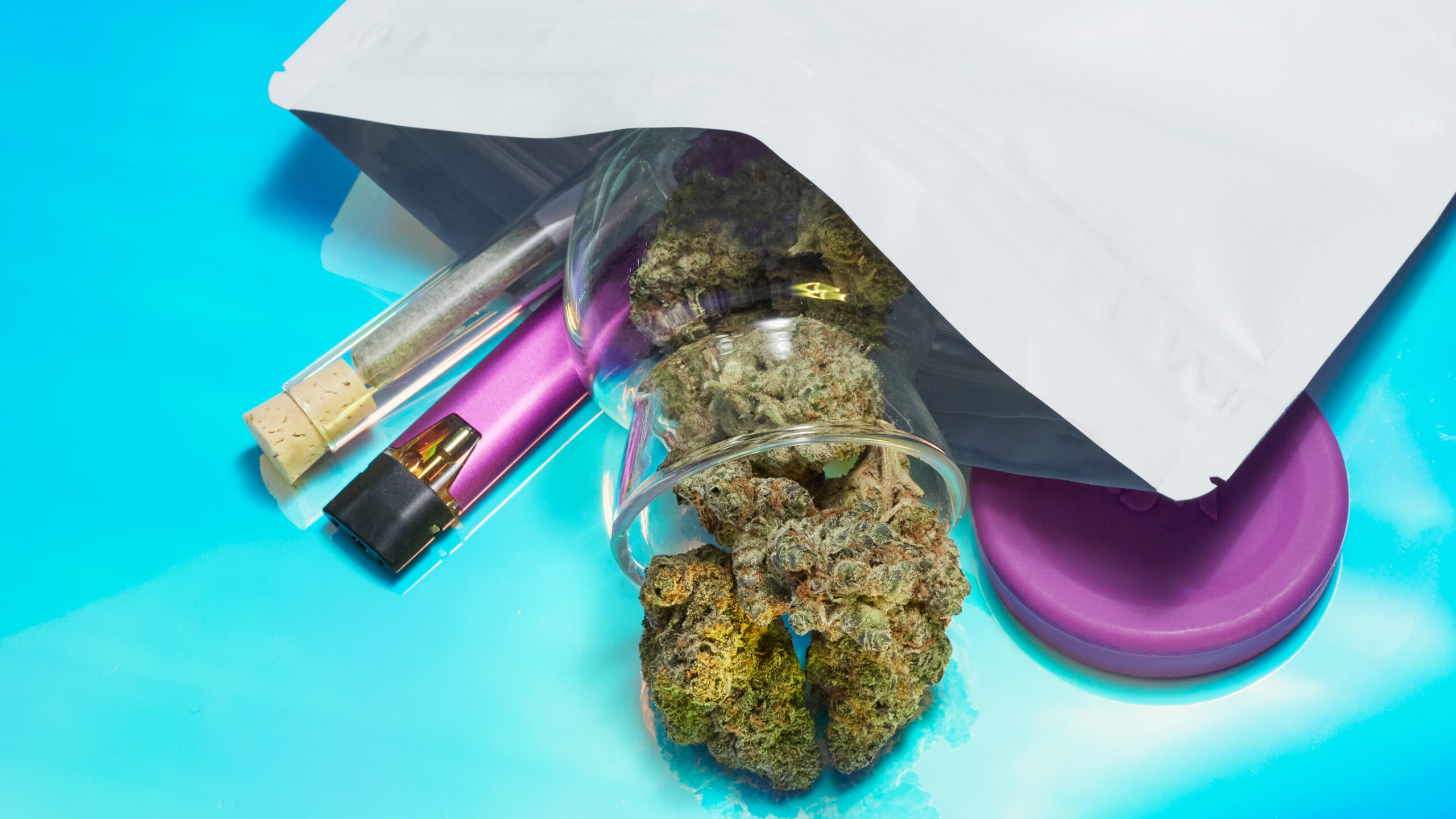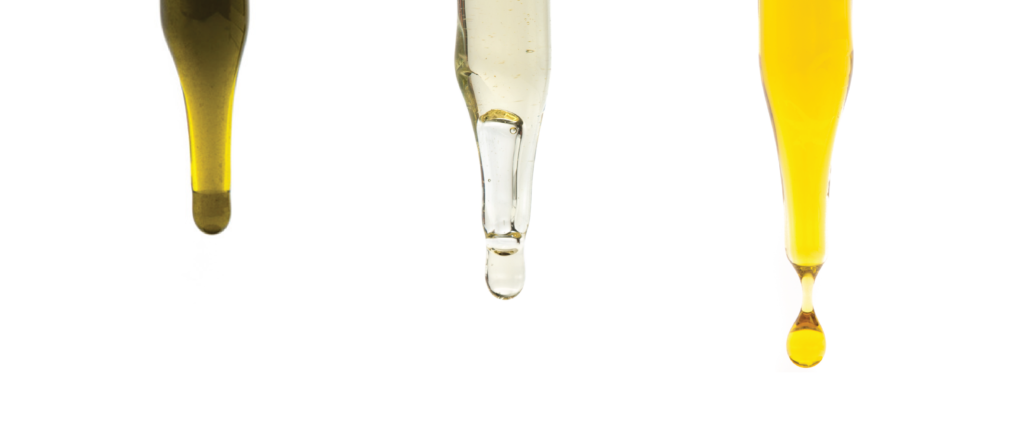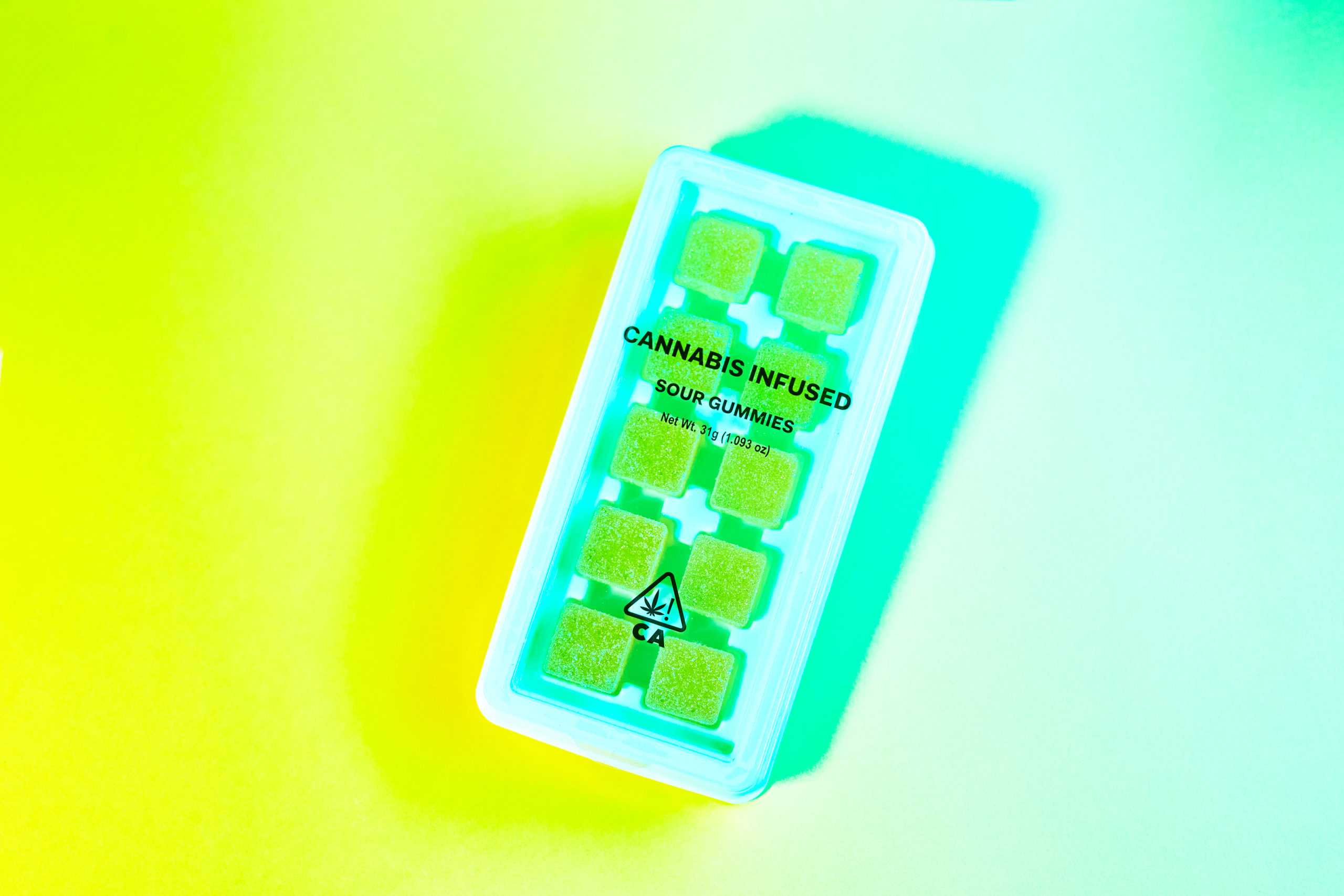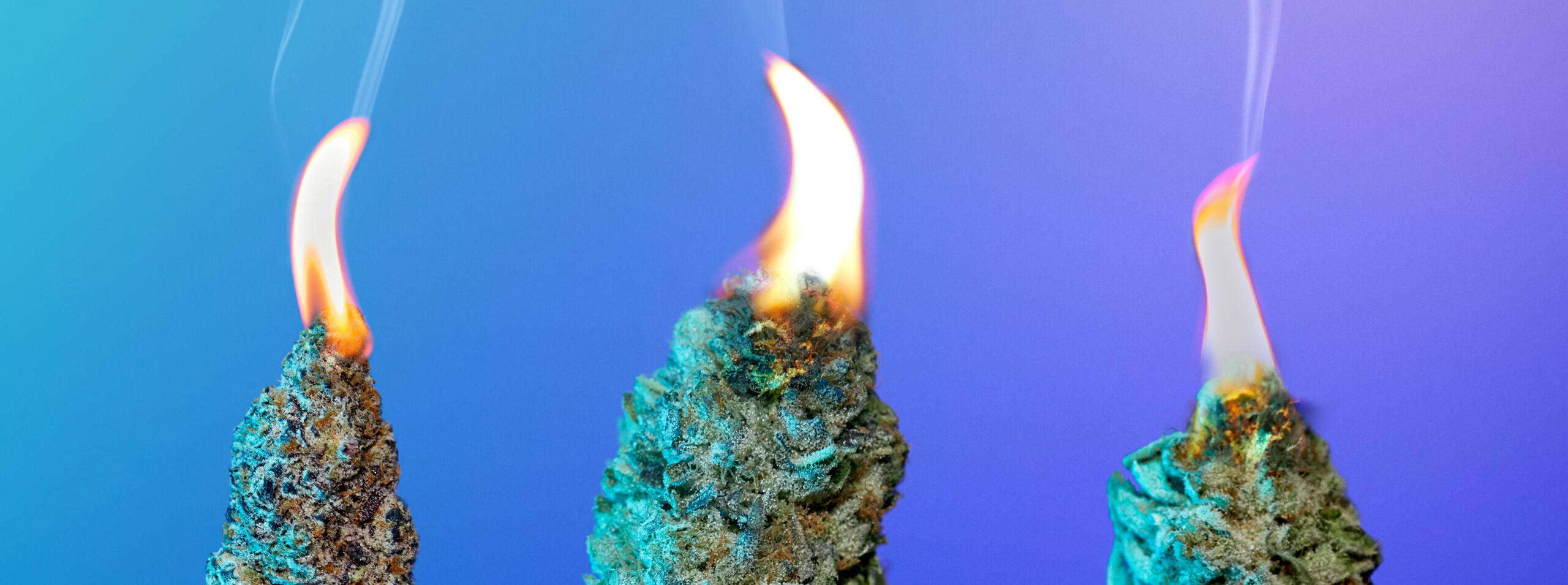Once you've found your ideal THC dosage, from the optimal milligram range or THC percentage that works best for you, the vast world of cannabis is yours to explore. Is your perfect dose 5 milligrams of THC or 30 milligrams of THC?
Learn how to find your correct dose by product type, adjust the dose incrementally, and how different factors can affect a cannabis high.
What is a good starting THC dose?
If you're trying THC (tetrahydrocannabinol) for the first time or are consuming it after a prolonged tolerance break, we recommend starting with a low dose, either as a single hit from a joint or a quarter of the edible you purchased from a dispensary. This usually comes to about 2.5 - 5 milligrams of THC.
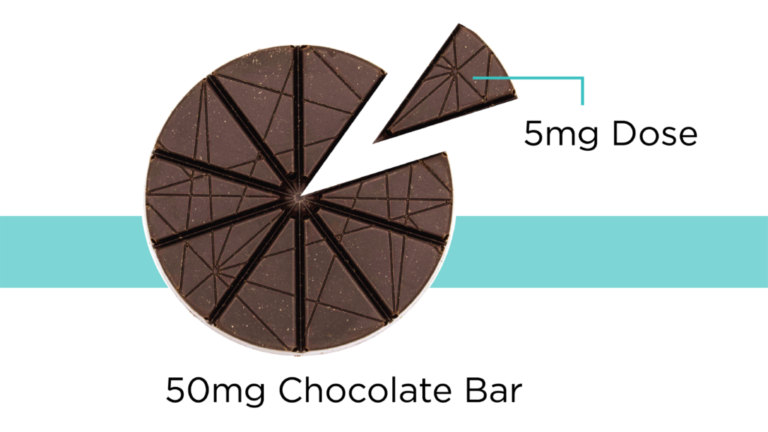 Photo by: Weedmaps
Photo by: WeedmapsImage lightbox

THC is an intoxicating compound that can cause psychoactive effects, so taking a low dose to start can help minimize the risk of unwanted side effects like anxiety, paranoia, or discomfort — all of which can happen if you take too much. You'll be able to find the THC content on the packaging of a licensed, lab-tested THC edible or tincture. Finding the right starting dose with smokeable products — like joints and vapes — is a bit trickier, but generally, you can take one puff and wait 15 minutes to see how you feel before taking more.
How is THC content calculated?
Calculating the THC content of cannabis products is relatively complicated, but here's a streamlined overview of the process:
- Sample: Brands will take a sample of the cannabis product — whether it's a batch of flower, concentrates, or edibles — that accurately represents the rest of the batch. For example, to test flower, you need to sample buds from different parts of the plant, not just the ones at the very top.
- Extract: Then, they extract the THC, other cannabinoids, and terpenes using a solvent like ethanol.
- Test: Next, chromatography techniques like high-performance liquid chromatography (HPLC) or gas chromatography (GC) are used to separate and determine the percentage of cannabinoids and other compounds in the sample.
- Quantify: Brands will then analyze the chromatography data and quantify the THC content in the sample.
- Report: Using some formulas, brands will translate and report the THC content they found as milligrams or a percentage of the total weight, depending on the product type and regulations. Consumers can find these reports on each product's certificate of analysis (COA).
THC dosage chart by type of product
The type of cannabis product you're interested in consuming plays a significant role in determining how much you need to consume to feel high. Use these general recommendations as a guide:
| Product Type | THC Dosage Recommendation for Beginners | Time to Feel High | Duration of High | Potential Benefits |
| Edibles | 2.5 - 5 mg | 30 minutes to 2 hours | 4 - 8 hours | - Long-lasting relief - Can feel effects throughout head and body |
| Flower for smoking | Less than 20% THC, one puff | Almost immediate | 1 - 3 hours | - Quick relief - Easier to titrate dose during the session compared to edibles |
| Vapes | 70% THC or less, one puff | Almost immediate | 1 - 3 hours | - Quick relief - Less harsh on the lungs than smoking - Easier to titrate dose during the session compared to edibles |
| Tinctures | 2.5 - 5 mg (per dose) | 15 - 45 minutes | 2 - 4 hours | - Precise dosing - Easy to add to foods or drinks |
| Concentrates | 70% THC or less, half a grain of rice | Almost immediate | 1 - 3 hours | - High potency - Used sparingly for strong relief |
Since cannabis compounds can interact with some pharmaceuticals, consult with a healthcare practitioner before using cannabis if you take any medications.
Flower
 Photo by: Gina Coleman/Weedmaps
Photo by: Gina Coleman/WeedmapsImage lightbox

Smoking cannabis flower provides a quick onset of effects. You can expect to feel high within minutes of inhaling cannabis smoke, so you'll know whether you consumed too much or too little fairly quickly. That high will peak roughly 30 minutes after inhalation before tapering off for about an hour.
Cannabis strains vary widely in potency, cannabinoid content, and terpene content — all of which can affect your high. Luckily, lab-tested products purchased from licensed, legal dispensaries come with certificates of analysis that make the dosing process accurate and easy.
Look for the THC percentage on a package of cannabis flower to determine how much of an effect you can expect from one puff of a joint or bong rip.
- 10% THC or less: flower in this range is considered mild
- 10 - 20% THC: strong for beginners and often just right for casual consumers
- 20% THC and above: some of the strongest weed you'll find
Make a note of the THC percentage before you consume, take one puff, and wait 15 minutes before consuming more to understand how that potency affects you.
Vapes
Most vape pens and cartridges are pre-filled with cannabis oil, a type of cannabis concentrate. Vapes heat cannabis oil to its vaporization point, producing a potent vapor that cannabis consumers can inhale. Similar to smoking cannabis, vaporizing cannabis produces an effect within minutes that then peaks after 30 minutes or so.
Since vapes contain concentrated oils with 70% THC or more, they can produce a strong cannabis high with minimal effort. It's wise to exercise caution when trying vapes for the first time. Keep in mind the vape's THC percentage before you consume, then take one pull on your vape pen and wait 15 minutes before consuming more to get a sense of how that potency affects you.
Concentrates
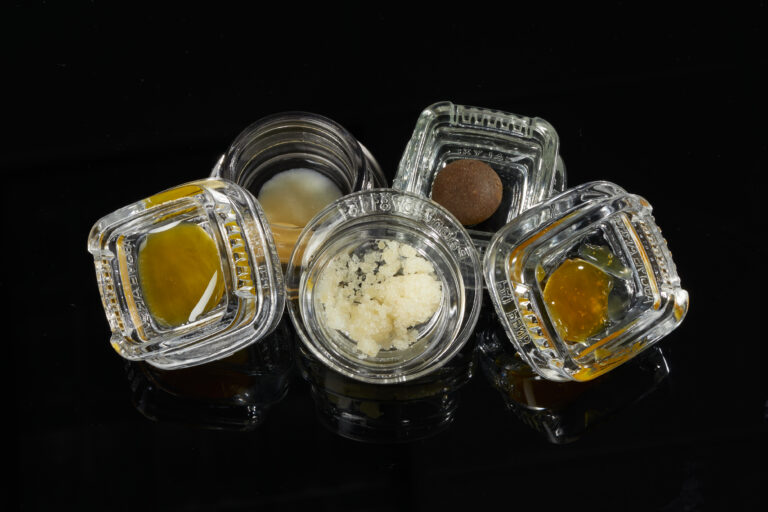 Photo by: Gina Coleman/Weedmaps
Photo by: Gina Coleman/WeedmapsImage lightbox

Cannabis concentrates are highly potent, containing an average of 60% to 99% THC. When sold outside of pre-filled vapes, cannabis concentrates can be consumed in larger quantities via a dab rig. Dabbing concentrates is considered an advanced consumption method, and as such, it's not recommended for beginner cannabis consumers.
Only seasoned, high-tolerant consumers should experiment with dabbing cannabis concentrates. Start with a scoop of concentrate half the size of a grain of rice when dabbing for the first time.
Tinctures
Cannabis tinctures are made by dissolving cannabis in an alcohol or oil solution. Tinctures can be consumed sublingually (under the tongue) or mixed into a beverage or food. When consumed sublingually, the effects of a tincture typically kick in within 20 to 30 minutes and last two to three hours. When consumed like an edible (i.e., mixed into food or beverage), the experience is similar to that of an edible.
Ideally, tinctures are meant to be absorbed via blood vessels in the mouth. This requires dropping some tincture under the tongue, allowing the product to remain in the mouth for two to three minutes, and even rubbing it in to ensure absorption. Should you swallow the tincture before it's fully absorbed, it will operate more like an edible, taking longer to kick in and providing effects for much longer.
Exercise the same caution with tinctures as you would with edibles. Start with a THC dosage of 2 – 5 milligrams and gradually increase the dose by one milligram every 24 hours until you find the ideal dose for you.
Edibles
 Photo by: Gina Coleman/Weedmaps
Photo by: Gina Coleman/WeedmapsImage lightbox

The body processes THC differently when it's ingested rather than inhaled. After digestion, the liver transforms THC into 11-hydroxy-THC, a more potent compound that lasts longer and has more sedating properties than THC. The effects of an edible can take anywhere from 30 minutes to two hours to kick in. Once they do, the effects can last several hours, depending on the dose and the consumer's metabolism.
So far, we've been talking about THC in terms of percentages, but with cannabis edibles, the potency is measured in milligrams. For example, a tin of weed gummies at your local dispensary might have 100 milligrams of THC per package and 5 milligrams of THC per gummy.
For beginners trying to wrap their heads around what these numbers mean, here's a quick breakdown:
- 1 - 2 mg THC: typically the lowest dose you can find in single servings of edible products
- 2 - 5 mg THC: could be considered a microdose or low dose depending on your tolerance
- 5 - 10 mg THC: a common range for casual consumers
- 10 - 50 mg THC: considered strong for beginners
- 50 mg THC and above: considered very strong and typically reserved for medical patients and daily consumers with established THC tolerance
You can start with a dose of 2 – 5 milligrams of THC if you're trying edibles for the first time. Gradually increase the dose by one milligram at a time and wait 24 hours between each experiment until you find your ideal dose.
FAQ
How has THC content changed over the years? Have products become more potent?
Yes, today's cannabis products are a lot stronger than the weed of a few decades ago due to brands favoring stronger strains and producing more potent cannabis. Going from what is essentially two percent to 20 or 25 percent means there's a lot of potency in a couple of puffs, drops, or bites of an edible.
Is microdosing recommended?
Though microdosing has become a popular term in cannabis culture, from a medical standpoint, it's extremely vague on what the actual dose is to achieve a “micro” dose of cannabis. One reason for microdosing cannabis is that taking a small amount may help to access its desirous physical effects without a psychoactive high. However, to achieve your perfect microdose, you may have to go through some trial and error using different strains and products.
Why is the lowest effective dose the best dose?
"Start low and go slow" is common advice because it helps you avoid taking too much and experiencing adverse side effects. There's also clinical research to back it up. A 2012 study published in the Journal of Pain showed that patients with advanced cancer experienced more effective pain relief with fewer side effects by using lower doses of cannabis. Another study published in the Journal of Pain found that low doses of vaporized cannabis were equally effective in relieving nerve pain as higher doses and smaller doses were less likely to impact daily cognitive function significantly.
While there is no known lethal dose of cannabis, it's possible to experience unwanted anxiety or paranoia by consuming too much — also known as greening out. To avoid unintended consequences, start with the lowest dose of THC possible and increase it incrementally until you find the sweet spot for you.
What's the best way to find your ideal THC dosage?
Many experts suggest starting with sublingual drops as the best way to find your ideal dose since this method allows for small dosing increases. Swallow any saliva in your mouth so you're not diluting your cannabis, use your tongue to swirl the drops around your mouth, and then refrain from foods or drinks for the next 15 minutes.
How do you get unhigh?
To get unhigh after you've accidentally smoked or eaten too much cannabis, start by taking several deep breaths. Find a comfortable and quiet spot to curl up and keep breathing. Phone a trusted friend, partner, or roommate if you have paranoid thoughts. Ensure you care for your body by staying hydrated, eating a snack, and doing light physical activities like walking or stretching.
Remember: no one has ever died from consuming too much weed, and the feelings will pass in time.
What are some factors that may affect your experience with THC?
Your unique endocannabinoid system (ECS), which consists of cannabinoid receptors, lipids, and enzymes that greatly maintain your internal regulatory balance, can affect how you feel a THC high. All mammalian vertebrates have an endocannabinoid system that interacts with the cannabinoids we produce ourselves (endocannabinoids) and the cannabinoids found in cannabis (phytocannabinoids). How many cannabinoid receptors a person has and how their ECS operates affect their sensitivity to THC and other cannabinoids. This is also why some cannabis consumers find success with one milligram of THC while others require much larger doses.How quickly you develop a tolerance can also affect your high. Your ideal THC dosage can change over time as you develop a tolerance for the cannabinoid. The ECS is a highly tuned instrument that responds to overstimulation by diminishing cannabinoid receptors, meaning that higher doses will be required over time to achieve the same effect. You can keep your tolerance in check by taking tolerance breaks and being mindful of how much you consume.
This article was reviewed by Bonni Goldstein, MD, a physician specializing in cannabis medicine in Los Angeles, California, owner and medical director of CannaCenters, and medical advisor to Weedmaps.com.

